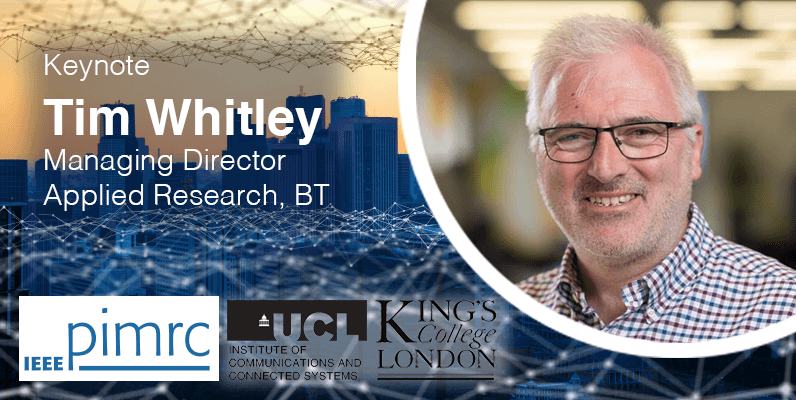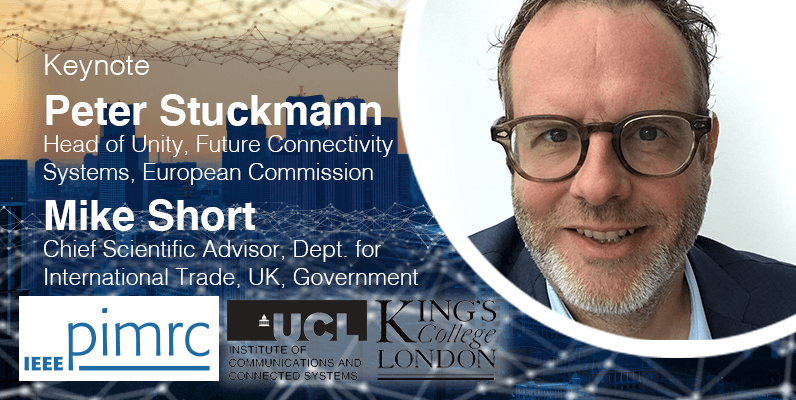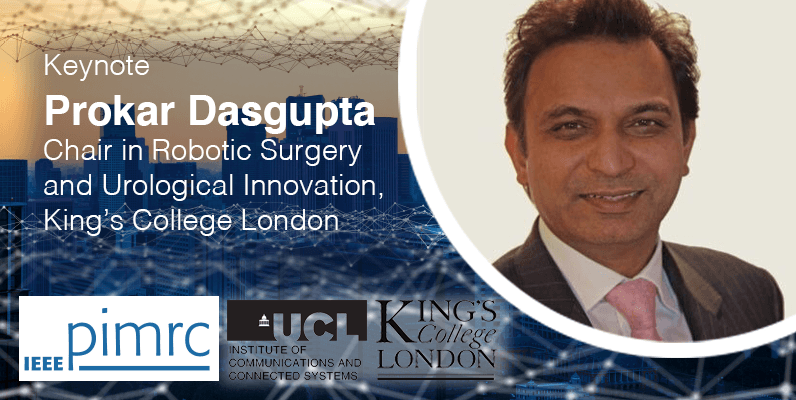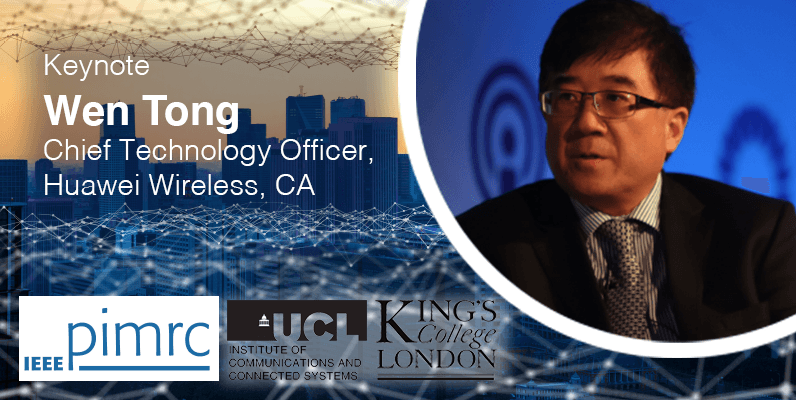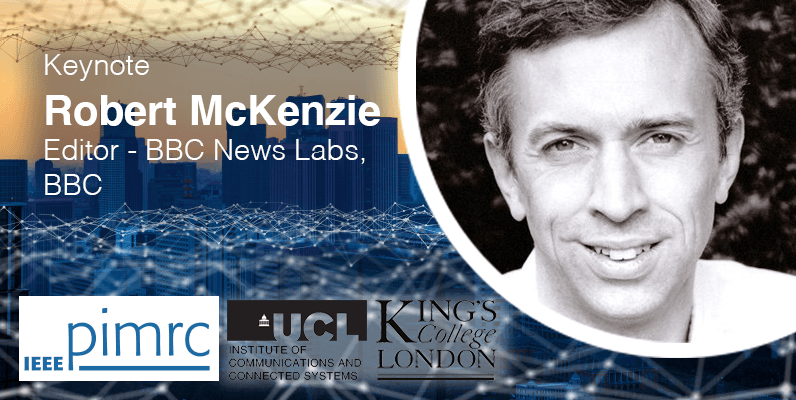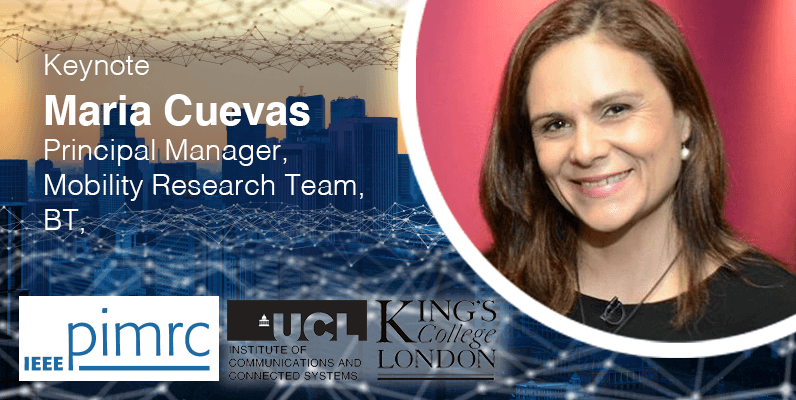PIMRC 2020 at UCL
Conference Chairs
General Chairs
Professor Izzat Darwazeh, Director of the Institute of Communications and Connected Systems at UCL
Professor Hamid Aghvami, King's College London
Technical Programme Chair
Professor Luis M. Correia, IST-U. Lisbon, PT
Keynote talks
Panel sessions
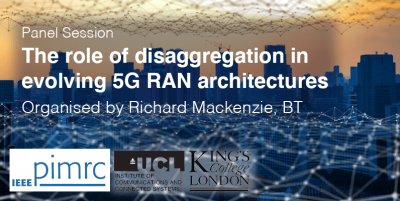
The role of Disaggregation in evolving 5G RAN architectures
5G radio access networks are still evolving. Significant enhancements include a move towards massive MIMO and wider spectrum bandwidths. In parallel, the whole RAN architecture is evolving to become densified, virtualised and disaggregated. Hence the RAN design is no longer just about the cell site and the backhaul, it now also includes fronthaul, midhaul, data centres (both cloud and edge). Many of these technology and architecture changes complement one another, however there are also many trade-offs.
The focus of this panel session will be to discuss the evolving 5G RAN design and to highlight where the main benefits are foreseen (or already experienced), what are the key trade-offs that can impact RAN design, and what are the main opportunities for us to steer the industry in the right direction.
Organised by: Richard Mackenzie, Researcher, BT
Panel members: Andy Sutton, Principal Architect, BT | Zahid Ghadialy, Senior Director - Strategic Marketing, Parallel Wireless | Anthony Magee, Senior Director Global BD, ADVA
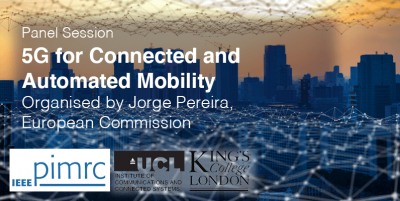
5G for Connected and Automated Mobility
This panel addresses the contributions of C-V2X (cellular vehicle to everything) and 5G to Connected and Automated Mobility (CAM). The state-of-the-art and 3GPP release timelines will be discussed in terms of the availability of solutions to provide real-time/critical CAM-related services.
An important requirement is to provide such services also in scarcely populated areas, mostly rural and peripheral – already an explicit EU 5G Action Plan goal for 2025 at least for major transport paths, mainly road, rail and waterways. Providing such coverage will require innovative investment solutions involving mobile and road operators, as well as rail and other infrastructure (e.g., energy) providers.
Similarly, providing advanced CAM services on top of more conventional 4G/5G services will require mixed Business Models, involving at least mobile operators and automotive OEMs.
The conclusions and recommendations from ongoing CAM Cross-Border Corridor projects, with broad cross-industry involvement, are extremely important in both regards.
Organised by: Jorge Pereira, Principal Scientific Officer, European Commission
Panel members: Foteini Setaki, Principle Scientist, Research & Development Department, Cosmote, S.A. | Vincent Park, Qualcomm Technologies Inc | Sushanta Das, Head of Advanced Technology -Advanced Connectivity Group, FCA | Markus Dillinger, Huawei Germany
Watch now
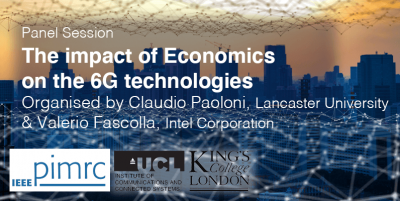
The impact of Economics on the 6G technologies
Neuromorphic computing, Tactile Internet, pervasive Virtual/Augmented Reality (VR/AR), telepresence, and first quantum computing deployments can be named as some of the new ingredients of the forthcoming 6G system. In addition, Terabit links will not be only the backbone of a network architecture, but will also be needed to enable data hungry applications at user level. Fascinating concepts (it is already predicted brain to mobile or brain to brain) and guaranteed user experience are so far beyond any currently available networks.
As the step towards 6G seems quite steep from the technology point of view, indeed economic aspects will even play a bigger role than in the just ended definition of the 5G system. Bigger leap forward in user experience and capabilities of a system imply huge investments.
How sustainable are such investments, in parallel to the ones needed to make 5G networks a reality not only in city centers but for a ubiquitous experience?
Do we need to have new or different stakeholders, in order to make the vision of 6G a commercial reality as well?
Is the assessment of new or better technologies ‘enough’ to have them deployed in the market or some other ingredients are to be added to the equation to make 6G a success for all the players in the ecosystem?
The panel will explore the above mentioned and some more aspects, defining the backstage of the 6G, investigating the subtle relationship between economics and technology.
Organised by: Claudio Paolini, Head of Engineering, Lancaster University & Valerio Fascolla, Director of Research and Innovation, Intel Corporation
Panel members: Theodoros Rokkas, inCITES Consulting | George C. Polyzos, Professor, Director AUEB/MMLAB | Maziar Nekovee, Managing Director - Quantrom Technologies
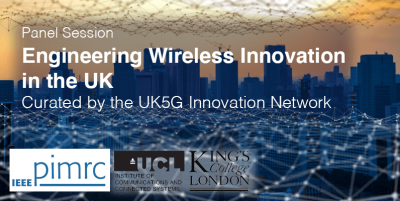
Engineering Wireless Innovation in the UK
Moving research from the laboratory into the real world is challenging. Complex new technologies must be deployed at scale in a highly competitive global market and be cyber-secure. 5G technology and engineering is often irrelevant to consumers and enterprises who just want outcomes and results. In a world impacted by Covid the vital importance of telecommunications cannot be overstated. Symposia such as these necessarily focus on the engineering challenges, but it is important to remember the needs of social care, health, transportation, and, of course, the impact of the climate emergency. How does the engineering community rise to these challenges and deliver the real impact that society so badly needs?
In the UK a novel combination of large and small private companies, National & Regional Governments, Innovation agencies, Research Institutions and Universities have been delivering a substantial programme of 5G Innovation projects exploring the real world application of 5G technologies, with the purpose of moving use cases to business cases. The programme has been considered successful and is expanding substantially.
The collaborative innovation landscape within the UK offers an environment where businesses work together with Universities and Government agencies in an open way.
Moderated by: Ros Singleton, Advisory Board Chair, UK5G
Panel members: Jessica Ellis, Head of Urban Connected Communities - 5G Testbeds &Trials Programme, DCMS | Ramsey Faragher, Founder - Focal Point Positioning | Vassilis Seferidis, CEO - ZEETTA Networks | Dritan Kaleshi, Head of Technology - 5G Digital Catapult
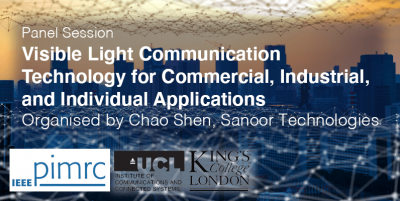
Visible Light Communication Technology for Commercial, Industrial, and Individual Applications
Visible Light Communication (VLC) has emerged as a novel optical communication technology that leverages ubiquitous lights to transmitting wireless data between devices. Operating on the visible light spectrum, it holds great potential to mitigate the problem of wireless bandwidth shortage in the near future. VLC has many unique characteristics, such as secure connection, license-free spectrum, data density, no electromagnetic interference, and thus show great potential to support existing applications or enable new applications, compared to its RF siblings. Despite the active researches in VLC technology and subsequently, the Light Fidelity (LiFi) network, many challenges remain unsolved when it comes to bringing the VLC to practical systems and a wide adoption in industrial, commercial and individual applications.
This Panel will focus on VLC-enabled networks, systems, and applications. Through discussion and presentation topics to be explored will includ the coexistence of VLC and RF technologies, novel designs to overcome the inherent limitations, and VLC systems for indoor localization, vehicular communication and IoT networks.
Organised by: Chao Shen, Chief Technology Officer, Sanoor Technologies INC., USA
Panel members: Harald Haas, Professor, The University of Edinburgh, PURELIFI LTD, UK | Jean Armstrong, Professor, Monash University, Australia | Volker Jungnickel, Head of Metro Access and In-house Systems Group, Fraunhofer HHI, Germany | Changmin Lee, R&D SLD Laser INC., USA
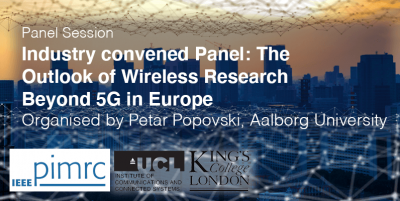
Industry convened Panel: The Outlook of Wireless Research Beyond 5G in Europe
A panel convened by Huawei.
Now that the deployment of the 5th Generation of mobile networks (5G) has successfully started all over the world, the obligatory “what is next?” question has appeared in the research community. From 3rd generation era, Europe has been kept playing the pioneer role in defining “What is next?” for each new generation. With the spirit of open research and innovation, quite a lot successful joint research and exploration activities between industry and academy have been supported by European Union. And now, as Commissioner Thierry Breton proposed, “without even waiting for the end of 5G roll-out, I want us to start working on 6G”. It is time to start think about how we could go together with join effort to create another technological miracle in next decade.
6G will be an achievement of globally joint effort from all beneficial partners on the ICT value chain. How the industry and academy from Europe can create the joint momentum and riding on the peak of the tide is question to be explored. The panel will investigate, with this joint momentum, how we can find out the new requirements, the new business models, the new technology trend, and maybe even more important, the new mode of joint exploration and innovation.
Organised by: Petar Popovski, Professor of Wireless Communications, Aalborg University
Panel members: Slawomir Stanczak, Professor for Network Information Theory, Technical University of Berlin | Nancy Alonistioti, NKUA | Luke Ibbetson, Group R&D Direcrtor - VDF, UK | Alex Werlberger, Chief Technology Officer - Holo-Light, Germany
 Close
Close


